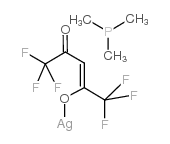Trimethylphosphine(hexafluoroacetylacetonato)silver(I), 99% (99.9%-Ag)
Modify Date: 2025-08-25 23:38:24

Trimethylphosphine(hexafluoroacetylacetonato)silver(I), 99% (99.9%-Ag) structure
|
Common Name | Trimethylphosphine(hexafluoroacetylacetonato)silver(I), 99% (99.9%-Ag) | ||
|---|---|---|---|---|
| CAS Number | 148630-66-4 | Molecular Weight | 390.99600 | |
| Density | N/A | Boiling Point | 95ºC 0,1mm | |
| Molecular Formula | C8H10AgF6O2P | Melting Point | 140-142ºC | |
| MSDS | N/A | Flash Point | N/A | |
| Name | Trimethylphosphine(hexafluoroacetylacetonato)silver(I), 99% (99.9%-Ag) |
|---|
| Boiling Point | 95ºC 0,1mm |
|---|---|
| Melting Point | 140-142ºC |
| Molecular Formula | C8H10AgF6O2P |
| Molecular Weight | 390.99600 |
| Exact Mass | 389.93700 |
| PSA | 39.89000 |
| LogP | 3.40260 |
| InChIKey | XCFNWYBRMNCHFP-UAIGNFCESA-N |
| SMILES | CP(C)C.O=C(C=C(O)C(F)(F)F)C(F)(F)F.[Ag] |
|
Section 1: Product Identification Chemical Name:Trimethylphosphine(hexafluoroaetylacetonato)silver (I), 99% (99.9%-Ag) CAS Registry Number:148630-66-4 Formula:Ag(CF3COCHCOCF3)P(CH3)3 EINECS Number:None Chemical Family:metal fluorobeta-diketonate complexes Synonym:Trimethylphosphinesilver (I) hexafluoroacetylacetonate
Section 2: Composition and Information on Ingredients IngredientCAS NumberPercentACGIH (TWA)OSHA (PEL) Title Compound148630-66-4100%0.01mg/m3 (Ag sl)0.01mg/m3 (Ag sl) Section 3: Hazards Identification Irritating to eyes, skin and respiratory tract. If inhaled or swallowed this compound may cause fluoride Emergency Overview: poisoning. Early symptoms include nausea, vomiting, diarrhea, and weakness Primary Routes of Exposure:Ingestion, inhalation, skin, eyes Eye Contact:Causes mild to severe irritation of the eyes Causes slight to mild irritation of the skin. Contact with the skin can lead to formation of dark blotches (silver Skin Contact: staining) Irritating to the nose, mucous membranes and respiratory tract. Inhalation Dust may cause fluoride poisoning. Inhalation: Ingestion may lead to dizziness, abdominal cramps, vomiting, bloody diarrhea, weakness, convulsions, and Ingestion: fluoride poisoning. Irritating to skin, eyes and respiratory tract. Ingestion may lead to dizziness, abdominal cramps, vomiting, Acute Health Affects: bloody diarrhea, weakness, and convulsions. Long term exposure to silver and silver salts can lead to the condition known as argyria - a general gray Chronic Health Affects:pigmentation of the skin and mucous membranes. Chronic fluoride poisoning can cause severe bone changes, loss of weight, and dental defects. NTP:No IARC:No OSHA:No SECTION 4: First Aid Measures Immediately flush the eyes with copious amounts of water for at least 10-15 minutes. A victim may need Eye Exposure: assistance in keeping their eye lids open. Get immediate medical attention. Wash the affected area with water. Remove contaminated clothes if necessary. Seek medical assistance if Skin Exposure: irritation persists. Remove the victim to fresh air. Closely monitor the victim for signs of respiratory problems, such as difficulty Inhalation: in breathing, coughing, wheezing, or pain. In such cases seek immediate medical assistance. Seek medical attention immediately. Keep the victim calm. Give the victim water (only if conscious). Induce Ingestion: vomiting only if directed by medical personnel. SECTION 5: Fire Fighting Measures Flash Point:not applicable Autoignition Temperature:none Explosion Limits:none Extinguishing Medium:none required If this product is involved in a fire, fire fighters should be equipped with a NIOSH approved positive pressure Special Fire Fighting Procedures: self- contained breathing apparatus and full protective clothing. Hazardous Combustion andIf involved in a fire this material may emit toxic fumes. Decomposion Products: Unusual Fire or Explosion Hazards: No unusual fire or explosion hazards. SECTION 6: Accidental Release Measures To avoid raising dust, small spills may be mixed with diatomaceous earth, sand, vermiculite, or other suitable Spill and Leak Procedures: inert material and swept up. SECTION 7: Handling and Storage Handling and Storage:Store in a cool, dry place in a tightly sealed container. SECTION 8: Exposure Controls and Personal Protection Eye Protection:Always wear approved safety glasses when handling a chemical substance in the laboratory. Skin Protection:Wear protective clothing and gloves. Ventilation:Material may form a fine dust. If possible, handle the material in an efficient fume hood. If ventilation is not available a respirator should be worn. The use of respirators requires a Respirator Respirator: Protection Program to be in compliance with 29 CFR 1910.134. Ventilation:Material may form a fine dust. If possible, handle the material in an efficient fume hood. Additional Protection:No additional protection required. SECTION 9: Physical and Chemical Properties Color and Form:white to yellow xtl. Molecular Weight:391 Melting Point:140-142°C Boiling Point:subl. 95°C/0.1mm Vapor Pressure:no data Specific Gravity:no data Odor:none Solubility in Water:slightly soluble SECTION 10: Stability and Reactivity Stability:air and moisture stable Hazardous Polymerization:no hazardous polymerization Conditions to Avoid:none Incompatibility:mineral acids, oxidizing agents and active metals Decomposition Products:carbon monoxide, carbon dioxide, organic fumes, and silver salts. SECTION 11: Toxicological Information RTECS Data:No information available in the RTECS files. Carcinogenic Effects:No data Mutagenic Effects:No data Tetratogenic Effects:No data SECTION 12: Ecological Information Ecological Information:No information available SECTION 13: Disposal Considerations Disposal:Dispose of according to local, state and federal regulations. SECTION 14: Transportation Shipping Name (CFR):Non-hazardous Hazard Class (CFR):NA Additional Hazard Class (CFR):NA Packaging Group (CFR):NA UN ID Number (CFR):NA Shipping Name (IATA):Non-hazardous Hazard Class (IATA):NA Additional Hazard Class (IATA):NA Packaging Group (IATA):NA UN ID Number (IATA):NA SECTION 15: Regulatory Information TSCA:Not listed in the TSCA inventory. SARA (Title 313):Title compound: See category N740 for reporting. Second Ingredient:None SECTION 16 - ADDITIONAL INFORMATION N/A |
| Risk Phrases | 20/21/22-36/37/38 |
|---|---|
| Safety Phrases | 26-36/37/39 |